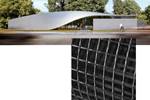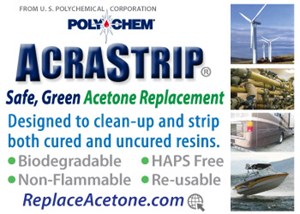
New automated process for higher-volume manufacture. Startup company WEAV3D Inc. has developed a patented, automated machine and process for weaving thermoplastic composite lattice structures at high volumes, for use as reinforcements in concrete, plastic or composite components in a range of industries. Photo Credit, all images: WEAV3D Inc.
One long-held barrier to widespread composites adoption, notably in the automotive industry, is the need for high-volume production and lower costs than are feasible with many types of composites manufacturing processes. Startup company WEAV3D Inc. (Norcross, Ga., U.S.) is seeking to solve these issues with its continuous, thermoplastic composite reinforcing lattice structures manufactured in an automated weaving process designed to be waste-free, cost-effective and, WEAV3D Inc. predicts, an enabler for high-volume production.
From concept to commercialization
Christopher Oberste, founder and CEO of WEAV3D Inc., developed the initial concept for his technology while earning his Ph.D. in materials science and engineering at the Georgia Institute of Technology (Georgia Tech, Atlanta) in 2014. His studies in polymer and fiber engineering and a co-op internship at GKN Aerospace North America (Tallassee, Ala., U.S.) sparked interests in thermoplastics and high-volume processes like compression molding and aerospace composites. This work led to the development of his first iteration for a high-speed, automated weaving process for thermoplastic composite reinforcing lattice structures. With the help and support of his Ph.D. advisor, Dr. Ben Wang, Oberste applied for and received grant funding to develop and commercialize his idea from the Georgia Research Alliance and the National Science Foundation’s Innovation Corps (NSF I-Corps) program.
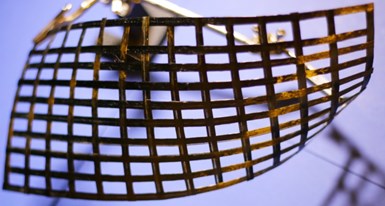
Material flexibility. WEAV3D uses thermoplastics for its lattices to achieve formability. Lattices can be supplied as rolls or sheets, or as semi-finished preforms.
For the next two years, Oberste worked with MBA and law students to commercialize the technology through a collaborative program at Georgia Tech called TI:GER (Technological Innovation: Generating Economic Results). By 2017, with additional funding from Megawatt Ventures and a U.S. Department of Energy Clean Tech University Prize, Oberste and co-founder Lewis Motion, a former U.S. Coast Guard helicopter pilot, founded WEAV3D Inc.; today, the company employs three full-time and four part-time staff.
Given Oberste’s and Motion’s backgrounds in aerospace, the initial plan was to qualify WEAV3D’s thermoplastic composite materials as reinforcement structures in aerospace components. However, Oberste explains that as part of the NSF I-Corps grant, he and his team had to perform a series of 100 interviews with potential industry customers, which led them to take a different direction. “We did a lot of discovery interviews in aerospace … but we heard time and time again that the path for startups going into aerospace, especially with a new manufacturing process, is very difficult. The adoption time is really long, and it’s very expensive. A lot of companies die before they can even make it to market,” he explains.
“The big focus for us, in the composites ecosystem, is that we are a game-changer for high-volume production.”
After speaking to companies in other industries, Oberste and his team decided to change their focus to the automotive and construction markets. He says, “Once we started talking to folks [in automotive], we realized there was a really big unmet need in that space, in that the automotive folks have a lot of pressing demand for weight reduction, but they are also sensitive on price. They told us that most of the conventional composite manufacturing processes available weren’t able to provide the volume they needed at the costs they wanted.” From there, Oberste set out to evolve his technology to be an enabling solution for producing high-volume composite parts at low cost.
The result is WEAV3D’s trademarked Rebar for Plastics concept. Using an automated weaving and consolidation process, WEAV3D manufactures dimensionally tunable, thermoplastic composite lattice structures designed to be easily integrated as a reinforcing material in a plastic or concrete part via compression molding, injection overmolding or other common high-volume processes. Based on simulation models, Oberste says this approach enables the production of automotive parts with performance on par with steel or aluminum sheet metal but which are lighter weight and 30-75% less expensive to produce versus composite parts formed via organosheet, automated tape laying (ATL) or hand layup processes.
The WEAV3D process
The WEAV3D process starts with off-the-shelf, thermoplastic unidirectional (UD) tapes. Oberste says the process can handle any type of thermoplastic and reinforcement fiber: “Our sweet spot for most of the work we’ve been doing in automotive and construction is in the polypropylene [PP], polycarbonate [PC], polyethylene terephthalate [PET] or polyamide [PA] space. We’re very agnostic in terms of reinforcement fibers, too, although glass and carbon fiber are of course the most popular.” He says the team has also done some work with conductive metallic tapes and is researching tapes with embedded fiber optics.
WEAV3D’s full-scale pilot machine is standardized to process a 25-millimeter-wide or 1-inch-wide tape, though Oberste says the machine can handle tapes as small as 5 millimeters (0.2 inches) wide with the use of adapters, and wider tapes with retooling. On the current machine, lattices can be produced up to 1.5 meters wide (60 inches), and up to five layers thick, at any length required by the application.

The first-gen system. WEAV3D’s pilot machine, designed to continuously form 25-mm-wide tapes into woven lattices up to 1.5 meters wide, uses IR heat and compaction rollers to consolidate the interlocking tapes together. The next-generation system will use ultrasonic welding.
The company’s November 2017 patent filing describes the WEAV3D system as “a machine for continuously fabricating a woven composite with controllable internal fabric geometry.” From spools loaded onto the machine, UD tapes are threaded into an array of independently controllable warp heads. Each head contains multiple tape channels, forming a warp shed, a space between the warp tapes for the weft-direction tapes to be threaded. An inserter stack dispenses unidirectional tapes in the weft direction through the warp shed to form a composite weave. The woven lattice is then pulled under an infrared (IR) light source and then through compression rollers to consolidate and bond the layers of tapes together at the interlace points. Depending on customer requirements, the resultant structure is provided as a flat sheet or as a roll, or WEAV3D offers additional trimming and preforming services.
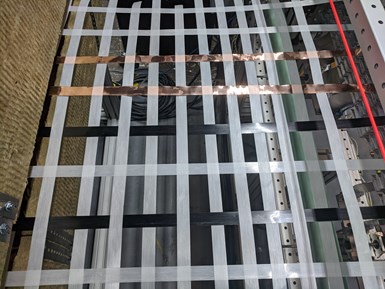
Mixing it up. One of WEAV3D’s advantages is the high level of tunability available per application, including a mix of different materials within the same lattice. Shown here is a mix of carbon fiber/PP, glass fiber/PP and copper tapes.
One of the most important benefits of WEAV3D’s process, Oberste says, is the high level of tunability of the lattice structure for different applications. This includes mixing different materials at different locations, as well as adjusting the density, or distance between the tapes, of the lattice structure. “We can really optimize the lattice structure for the requirements of the final product while minimizing overall costs.”
Once delivered to the customer, the lattices can be integrated into polymer concrete components, or compression molded, thermoformed or injection overmolded to form a final automotive composite part. The WEAV3D process can also accommodate varying levels of complexity. Oberste explains that for relatively simple parts, “this lattice can be combined with a lamination process and then thermoformed, just as a co-forming step. For moderately complex parts, we can do co-forming or preforming in compression molding, whether that's thermoplastic compression molding or SMC compression molding. And then for the very complex parts, we can actually preform the lattice into whatever shape it needs to be, place it into a tool and then do injection overmolding on that part.”
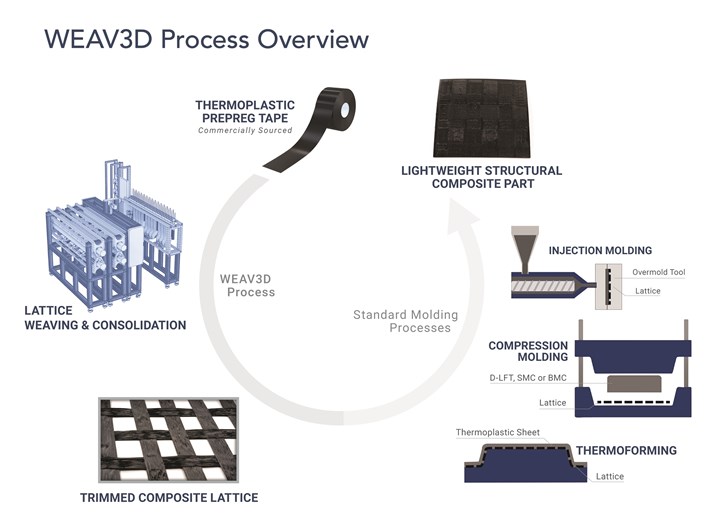
From tape to final part. WEAV3D’s tape lattices are designed for use in high-volume molding processes like thermoforming, compression molding, or injection molding.
“The big focus for us in the composites ecosystem is that we are a game-changer for high-volume production,” he adds. The exact volume depends on the application, but Oberste estimates that for lattice parts sized for reinforcing automotive door panels, WEAV3D’s machines can produce between 200,000 and 500,000 units per year.
In addition, the WEAV3D product has also exhibited enhanced mechanical properties when reinforcing a composite or plastic part. “Combining a WEAV3D lattice with existing short fiber plastics or long fiber composites can significantly increase the strength, stiffness and toughness of the resulting product,” Oberste says, though he adds that the amount of increase varies widely by the specific materials used and design of a particular part. “In some applications, this increased performance allows for part thickness or ribbing to be substantially reduced, which translates to reduced weight.”
Reinforced concrete trenches: First commercial application
For the first few years, the startup company’s focus has been on producing a manufacturing method and materials suitable for the automotive industry specifically, though Oberste has ideas about how this technology might be used in commercial aerospace interior components, unmanned defense aircraft, rail, cargo transport and marine applications.
For its first commercial application announced in November 2020, however, WEAV3D began with the construction market, using glass fiber/PET reinforcements for a polymer concrete trench system manufactured by Oldcastle Infrastructure (Atlanta, Ga., U.S.).
Oldcastle’s trench system, used for routing utility cables in urban areas, train stations or industrial plants, must be able to withstand 16,000-pound loads from vehicles driving over top of it. Previously, the trench was reinforced with custom-welded steel wire cages embedded into the concrete. However, according to Oberste, these steel cages were both expensive to custom manufacture and, as Oldcastle makes trenches of several different sizes, the steel cages were not always the correct dimensions to properly reinforce the trench’s drainage holes . “With our process, because we can really optimize the lattice for the application’s requirements, we were able to tune the lattice geometry — for example, to make sure we added reinforcement around the drain holes at the bottom of the trench, and reinforcement at the ends of the trench so that it’s protected against impact during handling,” he says.

First commercial application. The company’s first commercial application is a U-shaped glass fiber/thermoplastic lattice preform used to reinforce a polymer concrete utility trench. WEAV3D plans to expand into more construction and automotive applications in the near future.
In addition, one of the most challenging aspects of the project, Oberste says, was to identify a thermoplastic tape material that could form an adhesive bond with the polymer concrete, rather than relying on just a mechanical interface, as is the case with steel cage reinforcements. The polyethylene terephthalate glycol (PETG) material WEAV3D selected forms a true adhesive interface between the two materials, which helps with stress transfer and decreases the likelihood of fracture. “Even if fracture does occur,” he adds, “that fracture is much less likely to propagate through the structure because it has to overcome that adhesive interface.”
WEAV3D produces the lattices designed for this application as a U-channel preform, which Oldcastle then places into a casting mold where polymer concrete is poured over it, followed by cure and demolding to produce the final reinforced concrete structure.
Within construction, WEAV3D has plans to expand its lattices into other polymer concrete applications such as enclosures and lids. In October 2020, WEAV3D, in a joint proposal with Western Ontario University and structural engineering firm Entuitive, was awarded a grant from the National Sciences and Engineering Research Council of Canada to conduct research evaluating the use of WEAV3D’s lattices as reinforcement in traditional Portland cement-based concrete as well. The goal is to develop lattices that can be used as reinforcements for non-residential building slabs and facades, Oberste says.
Next-generation WEAV3D: Automotive speeds
A next-generation version of the WEAV3D machine, designed to meet the needs of automotive manufacturing, is in development with research funding from NSF. Oberste says it will likely come online in 2022. Improvements in the new system are targeted to triple the production speed of the current system, including the replacement of IR heating and compression rollers with more efficient ultrasonic welding.
At the same time, Oberste and his team have begun discussions with U.S. and European Tier 1s and OEMs in the automotive industry about the use of WEAV3D products to reinforce plastic panels, ranging from interior components to pickup truck tailgates. “One of the goals is to add a lattice as a structural skeleton within molded plastic components in order to improve their strength and stiffness and to replace metallic brackets and stiffeners that designers currently rely on,” Oberste says. WEAV3D is also working on demonstration articles of automotive body panels and other components to showcase the benefits of the material.
Related Content
Infinite Composites: Type V tanks for space, hydrogen, automotive and more
After a decade of proving its linerless, weight-saving composite tanks with NASA and more than 30 aerospace companies, this CryoSphere pioneer is scaling for growth in commercial space and sustainable transportation on Earth.
Read MorePlant tour: Joby Aviation, Marina, Calif., U.S.
As the advanced air mobility market begins to take shape, market leader Joby Aviation works to industrialize composites manufacturing for its first-generation, composites-intensive, all-electric air taxi.
Read MoreNatural fiber composites: Growing to fit sustainability needs
Led by global and industry-wide sustainability goals, commercial interest in flax and hemp fiber-reinforced composites grows into higher-performance, higher-volume applications.
Read MoreManufacturing the MFFD thermoplastic composite fuselage
Demonstrator’s upper, lower shells and assembly prove materials and new processes for lighter, cheaper and more sustainable high-rate future aircraft.
Read MoreRead Next
Carbon fiber-reinforced concrete accelerates in Germany
TU Dresden and C3 – Carbon Concrete Composite demonstrator aims to reduce concrete material use by 50% and CO2 emissions by up to 70%; Hitexbau touts high-volume automated production for carbon fiber textile grids.
Read More“Structured air” TPS safeguards composite structures
Powered by an 85% air/15% pure polyimide aerogel, Blueshift’s novel material system protects structures during transient thermal events from -200°C to beyond 2400°C for rockets, battery boxes and more.
Read MorePlant tour: A&P, Cincinnati, OH
A&P has made a name for itself as a braider, but the depth and breadth of its technical aptitude comes into sharp focus with a peek behind usually closed doors.
Read More

.jpg;width=70;height=70;mode=crop)
